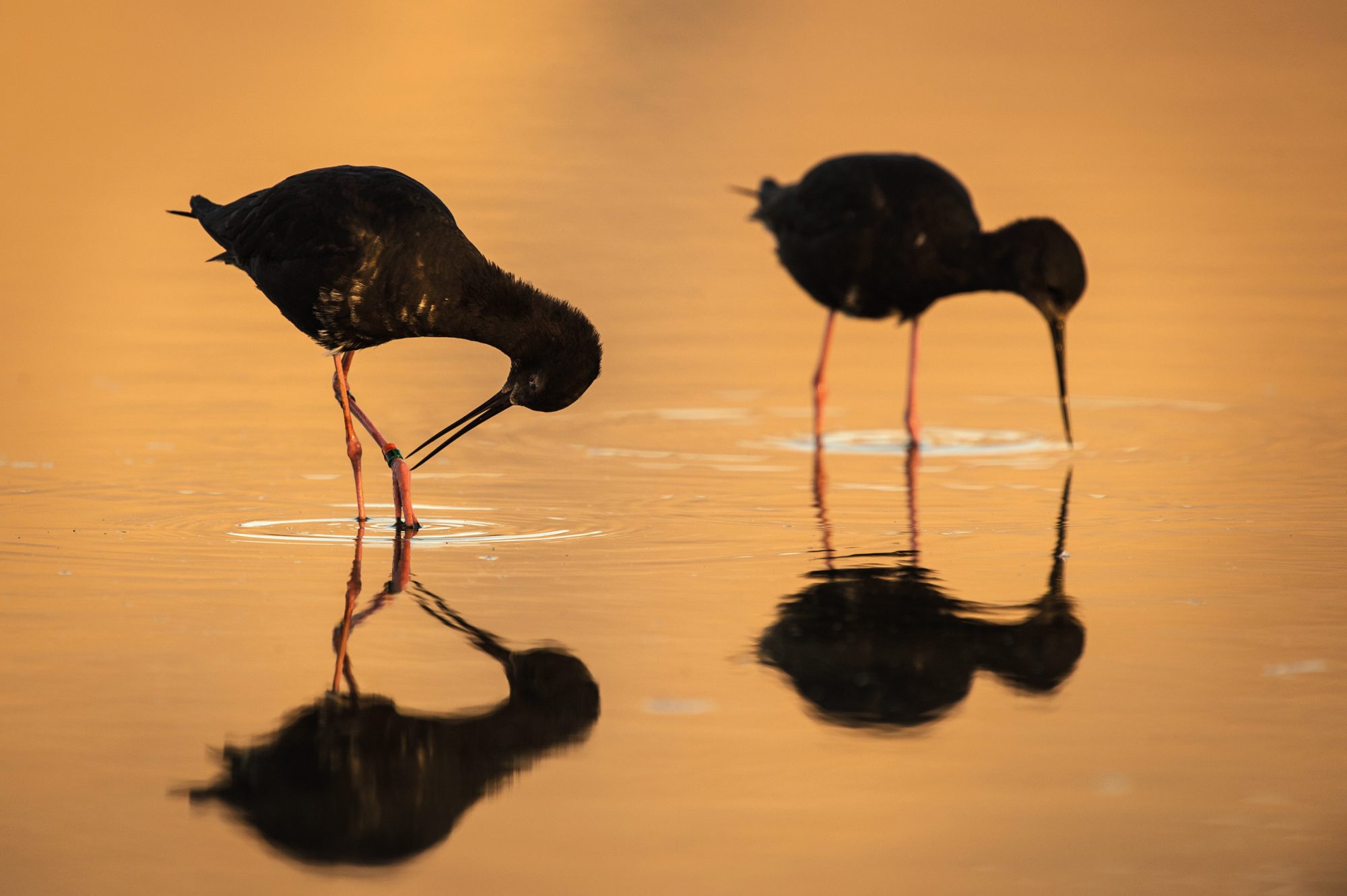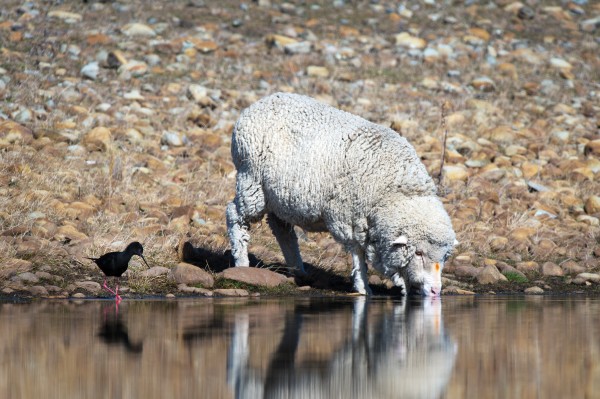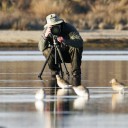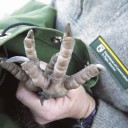
A delicate balance
Deep in the Mackenzie Basin, the world’s rarest wading bird roams free in the wild, unaware that behind the scenes, a handful of people are trying to solve a problem: how to protect a species that refuses to be contained?

“They’re quite little and they’ve got long legs that look too flimsy to support their bodies. They walk very elegantly—they don’t waddle.”
I’m describing how to identify a black stilt to a 18-year-old English backpacker, Steve, as we cross the tussock towards the Tasman River delta at the northern end of Lake Pukaki. Behind us, Aoraki/Mt Cook reaches above the valley. Ahead, the Tasman River splits into tendrils and meanders towards the lake. From above, the delta looks like a tangle of wet hair draped across the valley; on foot, it’s a maze of shallow streams separated by islands of tussock. There are no other humans in sight. No birds, either.
I came across Steve on the track to Mueller Hut the previous night, and swapped him a ride out of Mount Cook Village for his help looking for one of the 143 black stilts, or kakī, left in the world. It’s a clear autumn day, April Fool’s Day, and both of us think we’ve got the better end of the deal. Steve wasn’t an ornithology enthusiast to begin with, but I’ve just discovered he turned down another offer of a ride, his curiosity piqued by the idea of spotting a species that’s described as critically endangered.
We’ve got a lot of ground to cover. Kakī remain only in the braided river and wetland systems of the Mackenzie Basin, and Department of Conservation ranger Cody Thyne has told me that most of the population can be found feeding in the Tasman River delta at this time of year. Water levels have ebbed with the summer, exposing a buffet of invertebrates in the sticky mud, and kakī eat as much as they can in preparation for the winter. Many of their food sources will freeze over, but unlike the other birds I’ve seen in the Mackenzie so far, kakī don’t migrate.
I was expecting complicated, secret directions to this kakī feeding zone, but Thyne told me to take one of the gravel side roads after Glentanner Station, hop the fence, and go for a walk. I can’t quite believe it’s this simple—that DOC would leave kakī roaming around for anyone, or anything, to stumble upon. Of the 24 New Zealand birds categorised as critically threatened, most of the other 23 species are sequestered on offshore islands or enclosed in sanctuaries.

But the main challenge in protecting kakī is that they can’t be contained. They need open country, braided river habitat and an array of wetlands or tarns—a range of environments that enclosures and islands don’t provide. They also need complete protection from introduced mammals, a high-maintenance demand from a species that can, and does, fly across the Mackenzie in a day.
When kakī arrived thousands of years ago, they spread throughout the country, from the deep south up to Rotorua. They developed a collection of idiosyncratic New Zealand traits: an all-black coat, solitary nature, fearlessness of anything approaching at eye level, and refusal to budge from home, even when temperatures dip below freezing. “We’ve seen birds standing around in winter with ice on their wings waiting for the sun to melt it so they can get going for the day,” Thyne told me. “And they don’t carry fat, so that’s really tough.
There’s nothing to them if you hold them in your hand. They’re just 200 grams of leg; that’s about it.”
More recently, kakī were joined by the black-and-white pied stilt, or poaka, which is thought to have crossed from Australia a few hundred years ago. Poaka look like a black-and-white version of kakī, but they’re a separate species, and have different habits, born of life under a wider variety of threats. Kakī are loners; poaka nest in groups, finding safety in numbers. Kakī parents launch into the air when they sense a threat to their young; poaka parents drop to the ground and feign a broken wing to draw predators away from their nests. Like a more street-smart, sociable younger sibling, poaka proved better suited to the changing ecosystem at every turn.
Kakī do have a fighting streak, says Thyne—they’ll outcompete poaka for feeding territory on the river, or launch themselves straight at harrier hawks threatening their young. “They’re more aggressive than poaka—they’ll fight and keep fighting until poaka leave. If they’ve got chicks, they want to kill you. They just fly at you, dive-bomb you, all noise and manner like you wouldn’t believe. It’s a crazy aerobatic display.”
Yet kakī never learned to direct their aggression at the creatures that most threaten their existence: hedgehogs, cats, rats and mustelids, such as stoats and ferrets. Poaka grew to outnumber kakī 500 to one, while kakī continued to tread closer to the brink of extinction. By 1980, there were 23 left.
[Chapter Break]
Black bird-shaped splodges in the distance coalesce into Canada geese, which honk and scatter as we near them. “Kakī probably won’t run away from you,” I call to Steve, who is taking photos of mountains from a tussock island ahead of me.
Three black-and-white stilts fly past us in formation. I yell and point as they zoom past, but I’m not sure if they’re kakī or poaka. “Those might be the wrong ones,” I say as I catch up to Steve. “Or they could be teenage black stilts. They look almost identical when they’re young—they only become totally black when they’re older.”
Spending the previous day at DOC’s captive breeding centre in Twizel has turned me into a dispenser of kakī facts.

Kakī and poaka can mate, and for a time it looked as though kakī might hybridise themselves out of existence. Thyne says kakī will choose one of their own to pair up with, as long as they can find one. Stilts typically mate for life, forcing rangers to occasionally play the role of relationship police. “From time to time we will euthanise a poaka if it’s paired up with a kakī, but only if it’s in an area where there are other kakī that are the opposite sex,” he says. “Last year, I broke up a few unsuitable pairings down in the Ahuriri, thinking, ‘If we can get another kakī pair out of this, then it’s worth doing—just one pair.’ And that happened—two birds I’d shot, their mates came together and formed another pair.”
When the Wildlife Service first decided in the 1980s to intensively manage kakī, the survival rate of chicks in the wild was less than one per cent. The obvious first step was to relieve kakī of parenting duties, as the longer they sit on a nest, the more vulnerable they are to predators. The service built a compound and collection of aviaries down the hill from the power substation in Twizel, home base for a captive breeding programme that continues after 33 years. Almost every kakī now roaming the Mackenzie hatched here.
From spring to early summer, rangers become egg thieves, dispatched to the Tasman and Godley river deltas with spotting scopes. They’ll search until a lone kakī takes to the air, circles slowly, and lands: a sign that it’s nesting. When a breeding pair lose a clutch, they’ll lay again, up to four times. Each clutch is collected, provided it can be found, and delivered to the care of DOC aviculturist Liz Brown in Twizel. Kakī eggs are barely the length of a thumb, coloured light brown with a black paint-spatter effect, like bach wallpaper from the 1960s. Brown checks them for cracks, and paints over any fractures with red nail polish so they don’t lose moisture.
When I visit, the oven-like incubators are dark, awaiting spring. Brown takes two plastic ice-cream containers off a shelf—they hold all 172 eggs that hatched last summer. The shells are brittle, paper thin and almost translucent. Last season was the facility’s largest—so Brown ran out of space, and sent eggs to the privately run Isaac Conservation and Wildlife Trust in Christchurch to be incubated and hatched.

The ultimate measure of success, however, is recruitment—the number of young kakī that eventually form breeding pairs. Only a quarter of the juveniles Brown releases after eight or nine months become parents themselves. There’s still a way to go.
Part of the problem is the environment: the Mackenzie Basin isn’t necessarily the best place for kakī, says Thyne, it’s simply the last place—probably the last kakī habitat that mammals infiltrated. But predators are here now, and the land continues to change.
The tussock-covered intermontane valley where James Mackenzie famously grazed his stolen sheep remains sparsely populated, but not untouched. Of its six lakes, three are man-made, and the other three are dammed. Rivers have been diverted into canals supporting the Upper Waitaki hydroelectric scheme, the largest of its kind in the country.
Water is where arguments start in the Mackenzie. Kakī and a host of other species depend on waterways, but so do agriculture and electricity generation. Meridian Energy is permitted to vary the height of Lake Pukaki by nearly 15 metres, but a change of 15 centimetres in water level can be the difference between hunger and a good meal for kakī. A decision not to spill water from dams means that lake levels can remain steady or even rise rather than falling at the end of summer. “It floods dry areas that don’t have any aquatic life in them, and there isn’t as much food available there,” says Thyne. “There are all these bugs and worms available at 15 centimetres—that’s as deep as kakī can feed—and this is the time of year that they need to bulk up on food for winter, because winter’s really tough.”
Demands are mounting on the Mackenzie’s river systems. South of Twizel, tussock vanishes and rugby-pitch green takes over, an incongruous contrast with the tawny mountains in the distance. A proposal to irrigate another 4800 hectares of the Pukaki outwash plain is currently the subject of an appeal in the High Court.


Are the lumbering dairy cow and the light-footed kakī mortal enemies? That remains to be seen. Thyne says he’s beginning to notice kakī feeding under pivot irrigators. “I don’t necessarily support dairying in this environment—it’s got ramifications,” he says. “But in terms of kakī, perhaps it doesn’t. It might actually open up some habitat that wasn’t previously available. We can’t say at this stage.”
There’s little recent research into how irrigation affects the feeding patterns of braided river birds. A 1980s study of black-fronted terns on the Wairau River found the birds had a clear preference for feeding in aquatic rather than land-based habitats.
“I’ve witnessed a number of endangered species of bird feeding on or over irrigated pastures just as I have over dry pastures, and I think there’s room for research in that space,” says Lincoln University professor of environmental management Ken Hughey. Of course, any benefit to birds must be balanced against the concurrent loss of habitat that dairy conversation entails. “That makes it quite a complex equation, but it’s possible to measure it.”
As far as Thyne is concerned, farmers aren’t the enemy. Rather, he depends on them for land access and help spotting nesting birds—especially when wet seasons find kakī nesting near ephemeral ponds on private land rather than in riverbeds. “The biggest threats to braided rivers are habitat degradation and recreational users, I would argue. Some people think it’s their right to four-wheel-drive in any place they like.”
[Chapter Break]
Tussock has given way to mudflats criss-crossed by ankle-deep streams, and the sun is hot on the back of my neck. I’m rapidly gaining respect for rangers who spend long summer days searching for nesting kakī—there’s no shelter in sight, and the breeze is so dry it feels rough on my skin. Steve’s face has turned bright pink and I’m sure mine is too.
“This would be much easier if I had binoculars,” I say, then regret making it even more obvious that I’m a birdwatching amateur. My gaze is on a black blob up ahead that hasn’t moved at our approach, but I can’t tell whether it’s part of the landscape.
“How about this one?” asks Steve.
He has better eyes than I do. I have to get closer before it forms into a wedge-shaped body, perched on a single, improbable leg. A head pops up out of the feathers, and bobs up and down repeatedly—the sign, Liz Brown told me earlier, that it is measuring me up. Then, unhurried, it places its other leg down on the mud and walks a few steps to the stream. There, three other kakī are wading, dipping their bills now and again into the water with an air of polite dignity, as though this is a formal occasion. None of the pictures I’ve seen capture how graceful they are in real life. “Now there’s only 139 left to find,” I say.
[Chapter Break]
It’s the familiar New Zealand fable: odd-looking bird, perfectly attuned to one version of the world, can’t adapt when the revolution occurs, becomes the moral at the end of the story.
Liz Brown and her team want to move from intensive population management to maintenance, dreaming of the day when kakī chicks might struggle out of their shells to the shelter of tussock rather the orange plastic roof of a Hatchmaker.
But a self-sustaining population involves either removing predators entirely or accustoming kakī to them. And that begs the question: how do you teach fear?
At first, the captive breeding programme produced kakī that were too tame. Now, baby kakī grow up under the fixed gaze of a wooden adult stilt, rigged to play the
yep-yep-yep alarm call whenever chicks are handled by humans. When Brown plays it for me, it sounds like a recording of a small dog rather than a bird—one of the few calls that kakī make.
The next step is to instil a fear of mammals. Previously, experiments were conducted with a dummy cat on rails, but the fake predator didn’t really pose a threat, and Brown suspects that the young kakī were simply becoming accustomed to its presence.

Thyne thought a fearsome robot feline might do the trick, so he called up Weta Workshop staff, who connected him with an animatronics company that was only too keen to help. “They had this idea of a cat that comes screaming out and a high-pressure burst of air or water,” says Thyne. “It’s got to be a real, scary stimulus, just short of causing some problems for them.”
The robot cat wouldn’t just benefit kakī, Thyne is quick to add. “If it was effective, it would be transferrable to other species that are being released into the wild.”
The University of Otago was prepared to supply a researcher, but none of the parties involved could raise the $30,000 needed to set the project in motion. It has been on hold since late 2014, the latest setback in a long list of funding shortfalls for kakī. (Near the beginning of the captive breeding project, 18 proposals for science and research funding were rejected in a seven-year span.)
“People go, ‘The costs involved in this, is it worth it?’” says Thyne. “And I would say, ‘What sort of price do you put on biodiversity?’”
Conservation decisions are often framed in black and white: save the kakī, or save the $200,000 a year that DOC spends on the captive breeding programme. Without the captive breeding programme, the species would be functionally extinct within a decade.
In reality, it’s a choice to set one chain of actions in motion rather than the other. Protecting the kakī requires preserving their environment, which changes the way we use and access and think of the land. It’s not only a line in a budget, but a statement of what we value.

Thyne wasn’t sure what to say the first time someone asked him what was so special about kakī—especially when there’s a perfectly good black-and-white stilt in the neighbourhood. “I’d only been in the job six months; I couldn’t answer it at that point,” he says.
“It’s not that I don’t like the kakī, it’s just that I hadn’t had enough time with it. But then afterwards I thought about it. A black bird with red legs: it’s a Canterbury icon. It’s tough as boots because of where it lives, and it’s struggling, you know, not unlike people around this place.” Thyne laughs at himself. “That’s what I should have said, but I didn’t.”
The problem is, no one has had enough time with the kakī. It doesn’t have the celebrity of other critically endangered species—many of those recovery efforts are bankrolled by large corporates, with a corresponding boom in media coverage and public awareness. There’s the Bank of New Zealand and the kiwi, Genesis and the whio, Mitre 10 and the takahē. The kakī has a proud local winegrower, Black Stilt Wines, in support, but isn’t well known outside the Mackenzie. Perhaps this is because it isn’t a songbird, suggests Brown, or perhaps its character—alternately fierce and demure—only becomes apparent on long observation. Thyne shrugs. “We’re not marketers, we count birds.”
[Chapter Break]
I’m crouched down watching the four in the stream—there’s something captivating about their knobbly knees, like they’re skinny kids—when one starts making the yep-yep-yep call that signals danger. All of a sudden, one pair launch at the other, and the second two duck down, belly to the water, to avoid the onslaught. They take to the air, darting straight at each other then veering away at the last second, wings flickering open and shut: a high-speed battle where the opponents never make contact. Finally, the second pair retreat further downstream.
The threat to its lunch neutralised, the kakī closer to me bends one of its legs against the other, like a girl shifting her weight onto one hip, to sort through the feathers of its wing with its beak. The other lifts a foot to smooth the feathers about its face, and they continue to feed in silence. They look light enough for the ankle-deep water to sweep them away, but they continue walking upstream into the current, bills dipping now and again, placing one foot delicately in front of the other, taking each setback in their stride.
















